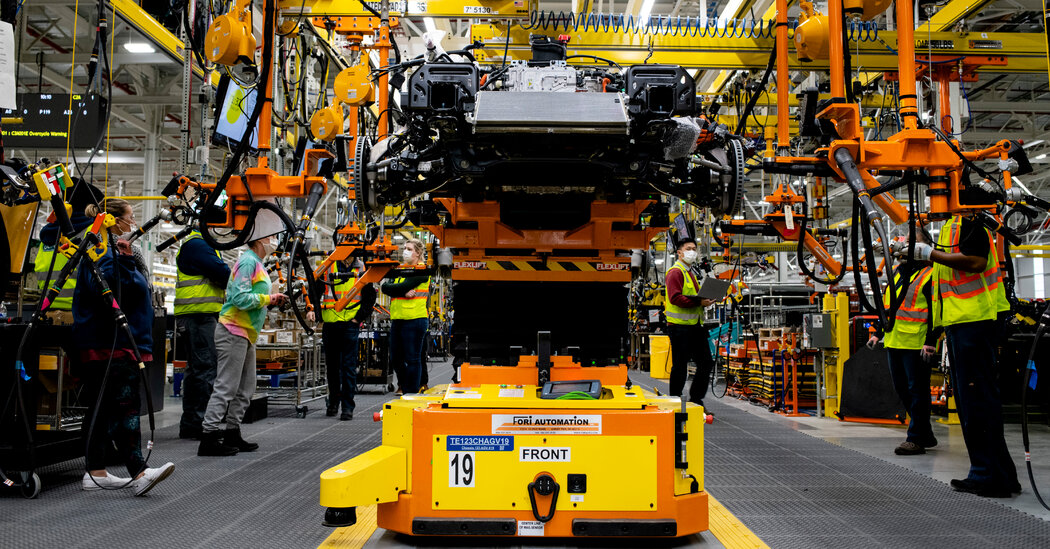The United Auto Workers union, which represents about 150,000 workers at U.S. car plants, could strike against three of the country’s largest automakers on Friday if the union and the companies are unable to reach new contracts.
The three automakers — General Motors, Ford Motor and Stellantis, which owns Chrysler, Jeep and Ram — could be forced to stop or slow production if an agreement isn’t reached by midnight on Thursday. The president of the U.A.W., Shawn Fain, said that Thursday was the “deadline, not a reference point.”
The union is negotiating a separate four-year contract with each automaker. The U.A.W. has never struck against all three companies at once, preferring to target one at a time. But Mr. Fain has said he and his members are willing to strike against all three this time.
What’s at issue in the labor dispute?
Compensation is at the forefront of negotiations.
The U.A.W. is demanding 40 percent wage increases over four years, which Mr. Fain says is in line with how much the salaries of the companies’ chief executives have increased in the past four years.
As of last Friday, the two parties remained far apart, with the companies offering to raise pay by 14 to 16 percent over four years. Mr. Fain called that offer “insulting” and has said that the union is still seeking a 40 percent pay increase.
What role is the switch to electric cars playing in the negotiations?
The auto industry is in the middle of a sweeping transition to battery-powered vehicles, and G.M., Ford and Stellantis are spending billions of dollars to develop new models and build factories. The companies have said those investments make it harder for them to pay workers substantially higher wages. Automakers say they are already at a big competitive disadvantage compared with nonunion automakers like Tesla, which dominates the sale of electric vehicles.
The U.A.W. is worried that the companies will use the switch to electric cars to cut jobs or hire more nonunion workers. The union wants the automakers to cover workers at the battery factories in their national contracts with the U.A.W. Right now those workers are either not represented by unions or are negotiating separate contracts. But the automakers say they cannot legally agree to that request because those plants are set up as joint ventures.
What happened in last U.A.W. strike?
The U.A.W. most recently went on strike in 2019 against General Motors. Nearly 50,000 General Motors workers walked out for 40 days. The carmaker said that strike cost it $3.6 billion.
The strike ended after the two sides reached a contract that ended a two-tier wage structure under which newer employees were paid a lot less than veteran workers. G.M. also agreed to pay workers more.
How would a strike against the three automakers affect the economy?
A long pause in car production could have ripple effects across many parts of the U.S. economy.
A 10-day strike could cost the economy $5 billion, according to an estimate from Anderson Economic Group. A longer strike could start affecting inventories of cars at dealerships, pushing up the price of vehicles.
The auto industry is in a more vulnerable place than it was in 2019, the last time the U.A.W. staged a strike. In the earlier part of the pandemic, car production came to a halt, sharply reducing the supply of vehicles. Domestic car inventories remain at about a quarter of where they were at the end of 2019.
Will a strike have political ramifications?
It definitely could.
President Biden has called himself “the most pro-labor union president” and sought to solidify his ties with labor unions ahead of his re-election campaign. But the U.A.W., which usually endorses Democratic candidates including Mr. Biden’s 2020 run, has withheld endorsing him for the 2024 race.
The union fears that Mr. Biden’s decision to promote electric vehicles could further erode union membership in the auto industry. Mr. Fain has criticized the administration for awarding large federal incentives and loans for new factories without requiring those plants to employ union workers.
Former President Donald J. Trump, who is most likely to secure the Republican nomination, has been seeking to win over U.A.W. members. He has criticized Mr. Biden’s auto and climate policies as bad for workers and consumers.











